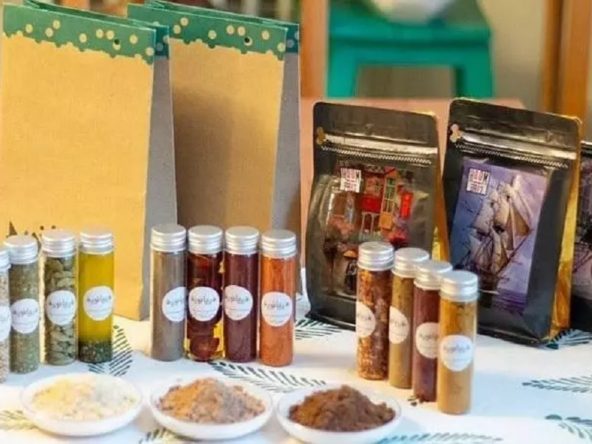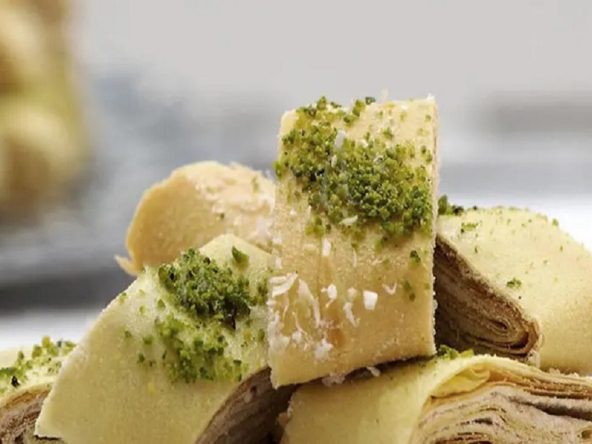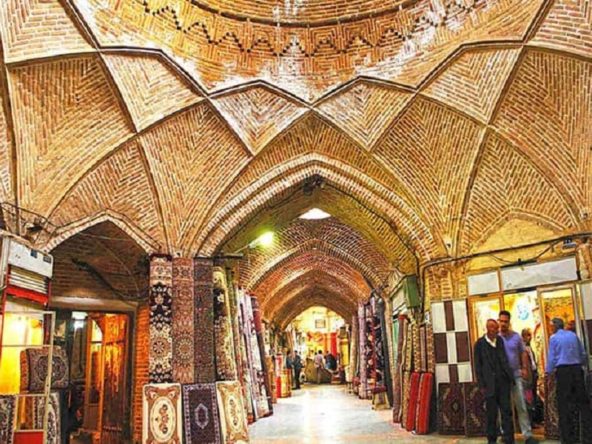Kerman Is the City of Various Souvenirs
Kerman, having seven Iranian National Heritages registered in the UNESCO World Heritage List, ranks first in Iran from this point of view. Thanks to its high-quality products, Kerman has been the first non-oil export of the country for several years. Many of these products are also souvenirs and are known among domestic and foreign tourists. Kerman souvenirs are very diverse and unique to Kerman province. In this article, we are going to introduce Kerman souvenirs so that you can bring the best gift for your friends and family without confusion.

Kerman: A City with Various Souvenirs
Kerman or Karmania in the ancient language is one of the important provinces of Iran from a historical perspective. Today, with the new provincial division, Kerman is considered the largest province in Iran. The capital of Kerman province is also a city with the same name. Kerman occupies eleven percent of Iran’s area and is the ninth most populated province of the country.
Kerman is an industrial, cultural, political, and agricultural pole among the provinces of the southeastern region of Iran. There are 660 registered national works in this province. Therefore, we can call Kerman province one of the most important and influential provinces of Iran. Kerman is one of those cities where after exploring its market and shopping centers, you will unknowingly come across a suitcase full of souvenirs. Kerman’s souvenirs are divided into two categories: foods and handicrafts, and each category will undoubtedly have its own fans. In the following, we will introduce edible souvenirs as well as handicrafts of Kerman.
Qottab: One of Delicious Kerman Souvenirs
Qottab is a delicious and famous sweet whose history is related to the Achaemenid period. Although Qottab is more known as a souvenir of Yazd, Kermani people have their own style and style in cooking Qottab. The difference in the intermediate ingredients of the dough is considered to be the main difference that exists in the Qottab of these two cities.

Yazidis use sugar with almonds, and Kermanis use a combination of sugar with ground pistachios or walnuts to fill the inside of Qottab. Qottab can be considered one of the most delicious and popular souvenirs of Kerman. Since Kerman is the birthplace of Iran’s pistachio, Kermani people usually use pistachios instead of almonds in this dessert and cover its outer layer with powdered sugar.
Komach Sahan
Komach Sahan is one of the traditional sweets of Kerman, which is made with wheat germ. In preparing this sweet, wheat germ is soaked and mixed with other ingredients such as cumin and cinnamon. The combination of these ingredients is added both to the Komach dough and to the middle ingredients of this sweet, such as dates, walnuts, or pistachios.
The use of wheat germ to prepare the basic dough of Komach Sahan has turned this sweet into one of the most nutritious and energizing traditional sweets and souvenirs of Kerman. Next, the dough prepared from the wheat germ after being dipped in cumin and cinnamon, is divided into two parts and used to cover the bottom and top of the sweets. A combination of dates and walnuts or pistachios is placed inside the pastry, then the pastry is carved into a rhombus shape and decorated with sesame and pistachio powder. Komach Sahan is one of the famous souvenirs of Kerman, if you visit this province, you must try it.

Qawut: One of the Energizing Souvenirs of Kerman
Qawut is a ground and powdered food product that is prepared by combining various nuts, seeds of medicinal plants, aromatic spices, wheat, sesame, barley, and chickpeas with sugar or coffee. Mixing it with water or milk is considered very useful for the body’s lost powers. Kermanis use Qawut to welcome guests and also to strengthen women who have just given birth.
Qawut is full of energy and a source of a lot of power. Qawut is often used with milk to strengthen memory as well as increase strength and treat insomnia. The yellow color of this powder is due to the combination of chickpea flour, sugar, and coconut. But if you want to buy the best and most powerful energy as a souvenir, we suggest you buy the brown powder which is a combination of wheat kernel, barley, cardamom, flax seed, black seed, purslane seed, coffee, and several other herbal medicines.
Kerman’s Kolompeh
Kolompeh is a type of sweet that is prepared by mixing the dough with cardamom, cinnamon, and rose water, and walnuts and dates are placed inside it. Cooking Kolompeh is more popular in some areas of the province, such as Bam. Some Kermanis make this cookie with animal oil. At the end, pistachio or sesame powder is poured on this cake. There are different molds for making Kolompeh, so you can find this sweet in different shapes and sizes in Kerman province.

Faloodeh: Another One of Kerman Souvenirs
Faloodeh is associated with the city of Shiraz, but this delicious dessert is prepared in different types throughout the cities of Iran. The people of Kermani also have a high skill in preparing Faloodeh, and Kermani Faloodeh is one of the important souvenirs of this province.
The preparation method of Kermani Faloodeh is similar to Shirazi Faloodeh, with the difference that in the Kermani type, mint and beet juice are used as seasonings, and syrupy eggs are used as decoration. If you travel to Kerman, be sure to try the Faloodeh of this province in traditional ice cream shops.
Cumin: The King of Spices
There is an Iranian proverb that says, “To take cumin to Kerman.” It is equivalent to the English proverb, “To carry coals to Newcastle.” Cumin is also one of the famous souvenirs of Kerman province, which has many culinary and medicinal uses. Kerman’s dry weather has provided a suitable platform for cumin cultivation throughout this province.
Cumin is available in two types, green and black, and its high-quality black type is collected from the mountains of Baft city in this province. Joopar Mountain is also famous for its cumin and 80% of the production of the province is allocated to this area. Kermani farmers harvest black cumin from mid-May to early July.
Pistachio: The Most Important Souvenir of Kerman
Pistachio is the most important souvenir of Kerman and is one of the export products of this province. 70% of pistachios produced in the country belong to Kerman. Pistachio needs a dry climate to grow, and Rafsanjan city is considered the largest pistachio growing area in the world, having a suitable environment for the growth of this valuable product.

The high quality of this product has made Rafsanjan pistachios exported to different parts of the world. It should be noted that pistachio export in Kerman province includes a major part of Iran’s non-oil exports.
Kerman Walnut
After pistachio, walnut is the second export product of Kerman province. This valuable nut is harvested from different cities of Kerman province, but the walnut of Baft city has better quality due to the location of its orchards at high altitudes. In terms of the area under walnut cultivation, Baft has first place in the production of this product in the country, and in terms of the amount of production, it ranks second after Tuyserkan and Hamedan. If you visit this city, be sure to try the quality walnuts.
Handicrafts: Another Souvenir of Kerman
Kerman souvenirs are not only limited to food and sweets. This city also has beautiful handicrafts, each of which can be a souvenir of the trip to Kerman or can be given as a souvenir and gift to friends and loved ones.

Kerman Carpet
There is another proverb in Persian that says, something is “like the Kerman carpet.” Its English equivalent is William Shakespeare’s quote: “For though the camomile, the more it is trodden on the faster it grows.” Many believe that the more the Kerman carpet is worn, the better its color will be. This proverb shows the quality of Kerman carpets since long ago. Kermani carpets owe their quality to high-quality wool and cotton yarn and are considered the most famous souvenirs of Kerman.
Afshari Rug
Afshari rug or Afshar rug is one of the most popular nomadic carpets in Iran, which has a worldwide reputation. These rugs are often woven by the Afshar tribe, which includes Shahr Babak, Sirjan, Baft, Raber, and Jiroft. Afshari carpet is considered one of the most important handicrafts of Kerman and has eleven different designs, including Heshmat flower, Abri design, Parisi double flower design, Three-headed design, Manbari, Musa-Khani, Jungle, etc. Lacquered, brown, cream, black, and navy colors are used abundantly in the texture of this type of carpet.
Shiraki Pich Kilim
Carpet weaving is an ancient art in Kerman, and historians attribute its history to the Afshar and Safavid eras. That is when Eilat Bouchagchi and Afshar entered Kerman. Sirjan’s Shiriki Pitch rug is one of the famous and unique rugs in terms of texture and design, because this rug is a combination of a rug and a carpet, and the wefts do not play a role in its texture, and the threads are the only ones that make their final shape. Sirjan and the village of Darrestan, which has been registered as a Glim Village by UNESCO, are considered the center and main pole of this exquisite art.
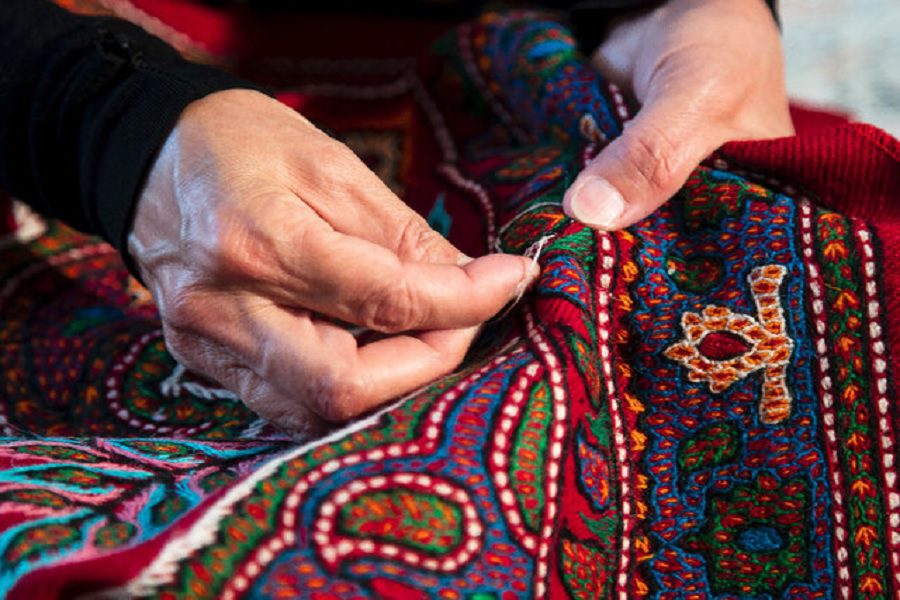
Kerman Pateh Sewing
Patchwork is considered to be one of the most famous handicrafts of Kerman, which was created by the hands of female artists of the city. To create this art, a woolen or cotton cloth called Bereh and Reis (colored and woolen threads) is needed, and of course, some taste and creativity of the women and girls of the city, to implement mental designs or ancient motifs. This art has been popular in Iran since the Safavid era and is considered one of the country’s oldest needlework.
Gabr-Sewing: An Embroidery of Kerman
Gabr-Sewing (Gabr-doozi) or Zoroastrian embroidery is an art that was created by the hands of Iranian Zoroastrian artists and had influences on the art of Europeans, Japanese, and Chinese during the Sassanid period. In the past, embroidered fabrics were used for wedding dresses and girls. In this art, peacock, tree, and flower designs are made with silk thread to create very delicate patterns on the fabric. The delicacy of Kerman embroidery is so much that the traces of the stitches can be seen only with a magnifying glass.
Kerman’s Ariz-Weaving
Broad weaving is an endangered art in which a kind of thick woolen cloth is produced. This fabric, which is often used as an undercoat fabric, was also used as a coat and overcoat fabric in the old days. In the not-so-distant past, this art was done entirely by wooden weaving machines, but today automatic machines have taken the place of these machines, and their output does not have the elegance and quality of previous designs.
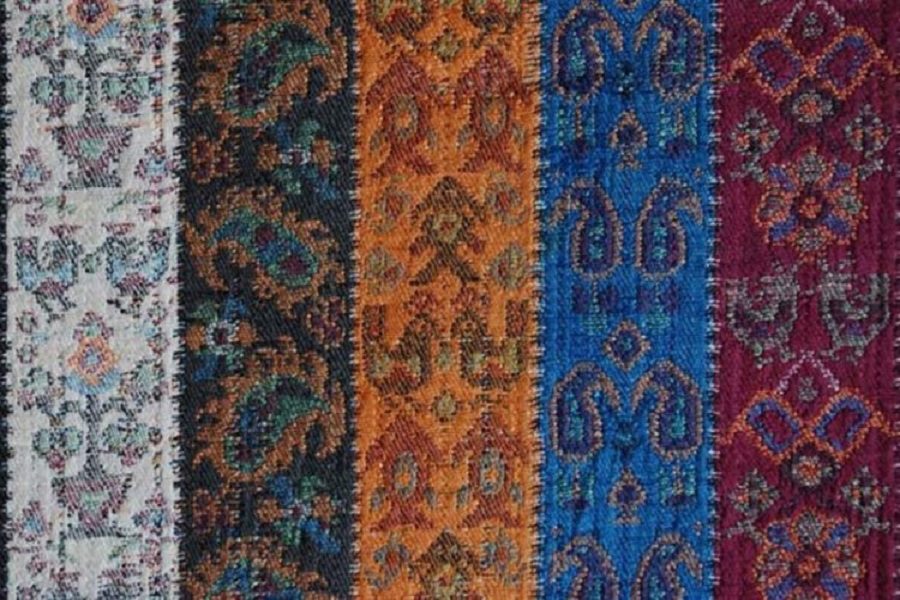
Kerman Shawl Weaving
The art of shawl weaving in Kerman has a more ancient history than carpet weaving, the adaptation of the old Kerman carpet designs from the designs used in the shawls of this country is proof of this claim. Among the arts of weaving, this art has been widely spread in Kerman since the past and the reception of buyers and lovers of Kermani shawls has fueled people’s occupation of shawl weaving. In the shawl shops of Kerman, various designs of lapis lazuli, bush, lacquer, deer horn, Ahrami, Termeh, and Zangari, which are often woven in three-meter dimensions, are offered.
Kermani Khorjin
In the past, it was common to use saddles on the backs of pack animals and bicycles, but today it is not popular. Nomads and some villagers of this province still weave Khorjins with symmetrical designs using cotton thread and woolen threads. It goes without saying that these bags are still used as one of the bride’s dowry items or as a place to store valuables among the nomads.
Kerman Copper Dishes
In addition to its use, the dazzling brilliance of copper dishes has always been an adornment of Iranian homes and kitchens. Kerman copper dishes are considered very valuable in terms of quality and durability because large copper mines are located in this city. Experienced coppersmiths of Kermani have been so artistic in producing copper dishes and decorative objects that it is unlikely that you will return to your city empty-handed after passing through their market.
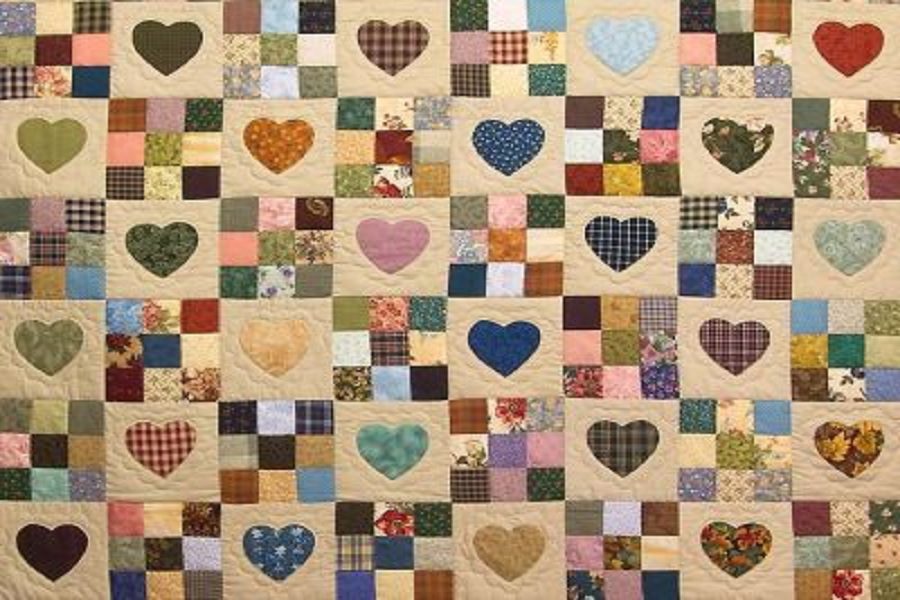
Kerman’s Ajide-Sewing
Ajide-Sewing (Ajideh-doozi) is also known by other names such as layered embroidery and cotton embroidery. These names are also directly related to the way of sewing this art. In Ajideh embroidery, this ancient Iranian art, a layer of cotton is placed between two fabrics, and then Kermani’s tasteful artists sew outstanding and picturesque designs on the fabric with unparalleled patience.
Kerman Mat Weaving
Kermani mat weavers intertwine threads from plant fibers to create one of the most beautiful handicrafts in Kerman. Although most people consider mat weaving to be unique to the northern regions of the country, this art has a lot to say in the city of Kerman and is used to weave hats, baskets, and all kinds of dishes.
Kerman Termeh
Cashmere is an exquisite and expensive fabric that is offered with very delicate fibers in the designs of Shah Abbasi and Paisley flowers in different cities of Iran, including Yazd. The people of Kermani have the ability to weave cashmere with their hands, and by visiting Kermani markets, you can buy the most beautiful cashmere.

Music Instrument: Kerman’s Artistic Souvenirs
The making of all kinds of instruments, violin, string, centaur, etc., is one of the brilliant handicrafts of Kerman province, which is done by the hands of experienced artists of the city. Master Hossein Masoud is one of the renowned artists in the field of instrument making and has a great reputation and expertise in making all kinds of instruments. You can visit Kerman instrument workshops to buy high-quality handmade instruments.
Buy Kerman Souvenirs from the Traditional Markets of This City
As you read, Kerman, like other cities in Iran, has many handicrafts and souvenirs, some of which we may not have heard of before. Although you can find souvenirs and handicrafts in most bazaars of Kerman. But to buy souvenirs and handicrafts of Kerman, it is better to go to the traditional markets of this city to enjoy the beauty of traditional markets in addition to shopping. The big market of Kerman is registered in the list of national works of Iran.




